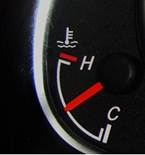| Dashboard lights |
| |
Hazard lights (warning lights) – Always red in color.
Always react to a red dashboard light by stopping the car in a safe place for you and other traffic. |
| |
| Some common red dashboard lights: |
| |
 |
Oil pressure warning light: If the light comes on during driving, what might be wrong? |
| Answer: Oil pressure in the engine lubrication system is too low. Possible reasons for this may be: Low engine oil level, malfunctioning or broken oil pump or clogged oil filter. |
|
What to do? Stop the car immediately and measure the engine oil level on the dipstick. Do not continue to drive the vehicle because you may damage or destroy the engine.
Click here to see how to check engine oil level and engine coolant level.
|
|
 |
Battery charge warning: If the charge light comes on during driving, what might be wrong? |
| Answer: The alternator has stopped generating electricity for the battery. |
|
What to do? Check the drive belt between the alternator and the engine for wear or damage. Also, the generator itself may have malfunctioned. You will still be able to drive for a while but you will use up the electricity in the battery in a short time. In some cars the same belt runs the alternator and the engine coolant pump. If that is the case you need to stop the car immediately in a safe place. Otherwise you may overheat the engine and damage or destroy it.
Click here to see how to jump start a dead battery (Icelandic)
|
|
 |
Brake warning light: If the handbrake is not engaged and this light comes on, what might be wrong? |
| Answer: There is a malfunction in the braking system and/or the brake fluid level is too low in the system. |
| What to do? The brake pads may be worn or the braking system is leaking fluid. Check the pads and look for leaks. |
| |
| |
How to check if the brakes are working properly?
You can check the brakes by stepping on the floor brake pedal. It should not “bounce” and must not go down further than 2/3 of the distance to the floor.
You can check the handbrake by stopping the car in a slope, putting it in neutral and engaging the handbrake. If the car starts moving downhill, the handbrake is not working like it should.
|
|
 |
Airbag indicator: What is wrong if this light comes on? |
| Answer: One or more of the airbags has malfunctioned. |
| |
|
 |
Engine temperature warning light and engine coolant temperature gauge: When the upper light comes on the engine coolant is overheating. The coolant temperature gauge below it also shows coolant temperature. When the needle reaches red, the coolant will be boiling. |
| What to do? |
| Stop the car in a safe place and turn off the engine. Wait for 15-20 minutes and then check the coolant level. Open the coolant reservoir cap carefully if you need to. The coolant will be hot and might be under pressure. |
|
| |
| Yellow lights (safety lights). If a yellow light lights up in the dashboard, you can continue driving, for example to the next auto repair shop. |
| |
 |
ABS indicator light |
| When the ABS light comes on, it means that the anti-lock braking system is not engaged. This means that you cannot brake in an emergency and steer the car at the same time. The brakes will still work. |
| |
|
 |
Engine warning light |
| The engine warning light coming on indicates some kind of malfunction associated with the engine. The car should be hooked up to a diagnostic computer in a repair shop to determine the malfunction. |
| |
| |
| |
| Changing a tire – a detailed description is required |
1. Drive out to the road shoulder and stop the car.
2. Turn off the engine and put the car in gear or park. Engage the handbrake.
3. Turn on the hazard lights and put the warning triangle up some way behind the car.
4. Take the spare tire, wrench and jack out of the trunk.
5. Loosen the lug nuts just a little bit.
6. Put the jack into position and jack up the car.
7. Remove the lug nuts and remove the tire. Install the spare tire instead.
8. Tighten the lug nuts, but not fully.
9. Release the jack and let the new tire down on the ground.
10. Fully tighten the lug nuts and put the damaged tire, wrench and jack in the trunk.
11. Have the damaged tire fixed as soon as possible. |
|
Click here to see how to change a tire. |
| |
| |